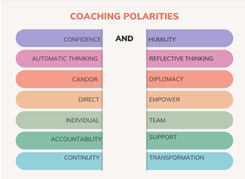As defined in the field of Polarity Thinking™, polarities are interdependent pairs of perspectives that need each other over time. Polarity thinking is both/and thinking, finding the right dynamic balance to fit the context.
Not all situations are appropriate for polarity thinking: some problems have to be solved with either/or thinking that chooses one side or the other. But in many situations, leveraging both perspectives skillfully can provide the benefits of both. Both polarity thinking and problem solving have value. The skill is to learn what the situation calls for – whether polarity thinking or problem solving, or both.
An example of a common polarity is the simple metaphor of activity and rest in preparing to run a marathon. We all know the advantages of activity in increasing cardiovascular endurance. We also know the benefit of rest for muscles and the cardiovascular system to recover/rejuvenate. If you over-focus on increasing endurance to the neglect of rest, then you can get injured. However, if you over-focus on rest to the neglect of increasing endurance, then your muscles will atrophy and your cardiovascular endurance will decrease. Each pole has something beneficial to offer, and each pole can get us into trouble if too much focus is placed on it. All polarities act in this dynamic oscillation between opposing poles just like activity and rest. Many coaching dilemmas can be posed in these terms.
Many effective coaches already intuitively use polarities in their day-to-day work with their athletes and teams. They do not see things as all or nothing. A more systematic and intentional approach to polarities can help coaches and teams better leverage tensions that don’t have simple permanent answers because there is at least some right on both sides. Seeing an issue as a polarity gives groups a way to work toward integrative/collaborative solutions to conflicts, rather than leaving one or both sides dissatisfied. Most polarities need ongoing work, since changes in the context often cause one pole to require more attention.
We have used polarity thinking extensively with coaches, individual athletes, and teams with significant success. We found that they picked up the concept quickly. Polarity thinking gave them a useful tool to explore new ways to work together.
For one example, coaches may experience tension between providing direction and empowering their athletes. When thinking of it as a polarity, some coaches have realized that they provided too much direction. Their athletes feel micromanaged. As a result of participating in the Polarity Thinking™ exercise, they were able to create environments where athletes were able to provide thoughts about team direction with a better balance, not only giving their athletes appropriate direction they need to grow, but also welcoming their ideas.
For another example, after being introduced to the polarity of individual and team, some athletes found that they were over focused on themselves and needed to invest more in maximizing team achievement. One team found that they didn’t allow the individual voices of younger athletes to be heard concerning team issues. They developed action steps to give those athletes opportunities to contribute.
Here are several common polarities found in coaching:
- Confidence and Humility
- Automatic Thinking and Reflective Thinking
- Candor and Diplomacy
- Direction and Empowerment
- Individual and Team
- Accountability and Support
- Continuity and Transformation
We can help you better understand how to use Polarity Thinking to leverage perennial tensions. By completing polarity activities, you can:
1) Gain insight into how effectively you are already leveraging the polarities that impact your team’s ability to achieve sustained success.
2) Learn more about the status of the polarity and the capacity to leverage both poles.
3) Develop action steps to better serve the polarity.
4) Recognize the early warning signs that you are getting out of balance.
For more information contact us through our website: www.thecoachingzonebook.com or John Yeager at john@yeagerleadership.com

